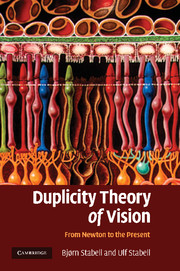Book contents
- Frontmatter
- Contents
- Acknowledgements
- 1 Introduction
- Part I The development of the basic ideas of the duplicity theory from Newton to G. E. Müller
- Part II The development of the duplicity theory from 1930–1966
- Part III Chromatic rod vision: a historical account
- Part IV Theories of sensitivity regulation of the rod and cone systems: a historical account
- Part V Factors that triggered the paradigm shifts in the development of the duplicity theory
- References
- Index
Part III - Chromatic rod vision: a historical account
Published online by Cambridge University Press: 22 January 2010
- Frontmatter
- Contents
- Acknowledgements
- 1 Introduction
- Part I The development of the basic ideas of the duplicity theory from Newton to G. E. Müller
- Part II The development of the duplicity theory from 1930–1966
- Part III Chromatic rod vision: a historical account
- Part IV Theories of sensitivity regulation of the rod and cone systems: a historical account
- Part V Factors that triggered the paradigm shifts in the development of the duplicity theory
- References
- Index
Summary
The finding that stimulation of rods alone may give rise to qualitatively different colour sensations came as a surprise, since it challenged the fundamental Principle of Univariance. This principle follows from Helmholtz's (1896) specific fibre-energy doctrine and implies that a given receptor or nerve fibre does not discriminate between variation in intensity and wavelength of a test light and hence mediates only one sensory quality. Accordingly, when only the rod receptor system is stimulated, variation in wavelength can be simulated by variation in intensity – they both produce variation in brightness only.
Indeed, the Principle of Univariance had been directly demonstrated by Graham and Hartline (1935). By analyzing the nerve impulses arising in the retina of the Limulus (horseshoe crab), where each photoreceptor is linked with a separate nerve fibre, they found that the variation in the response of the single fibres with wavelength could be simulated by suitably adjustment of the incident light energy. Thus, when the intensity was suitably adjusted, any test wavelength could be made to evoke the same frequency of impulses from a given receptor cell. Hence, it appeared that single retinal receptors alone had no power to discriminate between wavelength and intensity.
How, then, could the Principle of Univariance be reconciled with the new discovery that test stimulation of rods may give rise to all the principle hues of the spectrum? An answer to this question became apparent when it was discovered that the scotopic hues were due to rod-cone interactions.
- Type
- Chapter
- Information
- Duplicity Theory of VisionFrom Newton to the Present, pp. 108Publisher: Cambridge University PressPrint publication year: 2009



